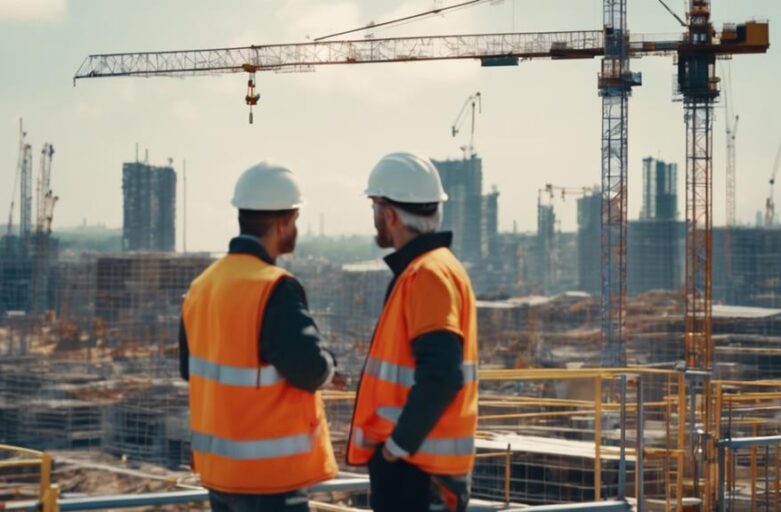Kick off your inspection of a construction site by setting easy-to-understand goals. This way, you'll know which parts of the site you need to look at and what you need to achieve.
Then, make your checklist. It should have things like checking safety equipment, controlling who comes in and out, how trash is managed, and how fire safety is handled.
Next, use your checklist to do the inspection, keep a close eye on how well safety rules are followed, and write down everything you notice.
Put together a summary and suggest ways to make things better. The more you follow these steps, the better your inspection will be.
Key Takeaways
- Create a simple-to-understand checklist that includes safety equipment, site protection, caring for the environment, and ways to prevent fires.
- Use easy designs or tools to make the checklist and give a score to each item on the list.
- Carry out the inspection carefully. Use pictures and write notes about what you see to make a detailed report.
- Make changes based on what the inspection report says and keep an eye on how well these changes are working.
- Build a culture where safety is important. Do regular checks to keep the work area safe and of good quality.
Establishing Inspection Scope and Objectives
Before starting a check-up at a building site, you should know what you're looking for and why. This means figuring out what parts of the site you'll look at, like the buildings, the tools, or how safe everything is. Decide what you want to achieve with this check-up; maybe you want to make sure everything is safe or focus on particular safety issues. Create your rating system early, focusing on keeping high standards.
Being prepared is essential. Understand what results you expect from the check-up. What'll be the end products? Perhaps you want to create a thorough report on how things are going at the site, or find areas that need to be better.
The success of the building project depends a lot on the management team, and you're a part of it. Knowing what your job is during regular check-ups, and what others are supposed to do is very important.
Checklists for building site check-ups are crucial for keeping things safe and running smoothly. By knowing what you're looking for and why, you're taking the first step towards a successful project. You should feel proud that you're helping make this project successful.
Formulating the Inspection Checklist
Creating an inspection checklist for a construction site is like making a safety map. It helps ensure everything is safe and follows necessary rules. Think of it like a school project where you have to hit all the critical points to get an A+.
Important areas to include in your checklist are safety gear, site security, care for the environment, electrical safety, and fire safety. This helps make sure your construction site is safe and follows all the necessary standards.
Your checklist should be simple and easy to understand. You can use a template or a computer program to make it perfect for your construction site. Include a rating system to easily review each area.
| Category | What to Check |
|---|---|
| Safety Equipment | Enough safety gear, equipment in good shape |
| Site Security | Safe boundaries, controlled access |
| Environmental Care | Handling of waste, controlling pollution |
| Electrical Safety | Safe wiring, correct tools, training |
| Fire Safety | Fire extinguishers, escape plans |
This table is like a mini-guide for your checklist. Each area should include what you find, what you see, and what you suggest to improve. This way, you can find and fix any safety issues. Doing this isn't just about filling in a checklist; it's like being a safety superhero for your construction site. Remember, a good checklist is your main tool in keeping your construction site safe.
Executing the Inspection and Reporting

Once you have your checklist ready, it's time to dive into the main job: doing the check-up and sharing what you found. Your job is to look over things regularly, paying special attention to things like how safe the equipment is. You look for any problems that might pop up, and help to keep the work site safe and top-quality.
First, you'll use your checklist to look at every part of your project. Your job is to make sure everyone is following the safety rules. Along the way, snap some photos, jot down notes, and save any important papers. All these things will help you make a detailed report about your inspection.
After you're done checking everything, you'll write a full report about what you found. This report is super important because it tells everyone else what you found during your inspection. It helps everyone understand what they need to do to keep the site safe.
Your report should say what needs to be fixed, what steps should be taken to avoid future problems, and what could make the site better. The main goal is to keep everyone safe. Once the fixes have been made, keep an eye on them to make sure they're working as they should.
Lastly, make sure to do more inspections if they're needed. This helps everyone stay responsible and keeps the site safe and high-quality. It's all about making sure the work site is a safe and effective place to be.
Conclusion
Okay, so you've figured out how to set up your inspection goals, create a good checklist, and carry out the inspection accurately. It's important to stay steady. Make sure your checklist is up-to-date, perform inspections often, and share results quickly.
Doing this will help ensure safety rules are always followed, lowering the chance of dangers at your construction site. Don't worry, inspections don't need to be scary – these tips will help you manage them easily.


